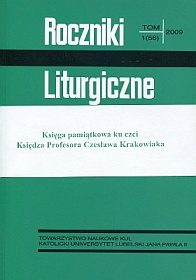Obrzęd chrztu świętego w Kościele anglikańskim
Abstrakt
In the Church of England baptism must always be administered with water in the name of the blessed Trinity, according to Jesus Christ’s command (Mt 28,19). As regards the effect of this sacrament marks a person’s new birth into God’s kingdom. It is a death to sin and comprehends gifts that by nature people cannot have. In it they are regenerated and made members of Christ and children of God. Baptism is something that happens to someone on the outside (being dipped in or sprinkled with water) as a symbol or sign of something happening on the inside (repentance, forgiveness and the gift of the Holy Spirit). The baptism of baby or an adult is a sign of the profound spiritual change which takes place when someone becomes a Christians. This is why this sacrament is celebrated as such an important event in the life of the Church.
There are two basic types of baptism service in the Church of England. There are baptism services that follow the order of service in the Book of Common Prayer of 1662 and there are those that follow the orders of service in Common Worship that were authorised for use from 1998. In spite of the differences there are a number of core elements that can be seen in the orders of service in both the Book of Common Prayer and Common Worship, elements that are central to Christian baptism and that can be found in services of baptism from very early time. In the case of the Common Worship services there is the option for additional elements, which are also practices that go back to the early days of the Church.
In the Anglican Churches godparents agree to take on three special responsibilities; to pray for the child, to set him a good example and to teach him. The Church expect parents and godparents to play their part in introducing the child to Christianity. Those who are older when they are baptized have sponsors rather than Godparents. The role of the sponsor is not to speak for the person being baptized, but to formally present them for baptism and to help them in their growth as Christians after they have been baptised.
Copyright (c) 2009 Roczniki Liturgiczne

Utwór dostępny jest na licencji Creative Commons Uznanie autorstwa – Użycie niekomercyjne – Bez utworów zależnych 4.0 Międzynarodowe.

